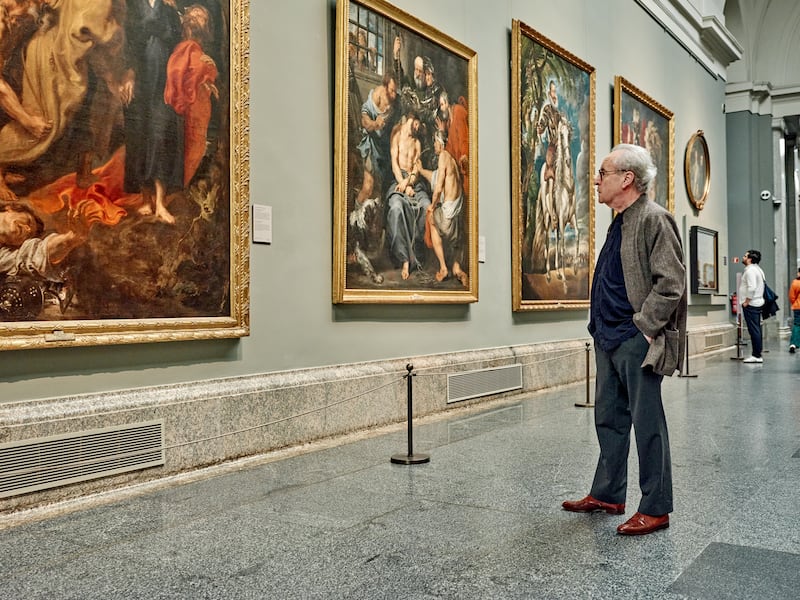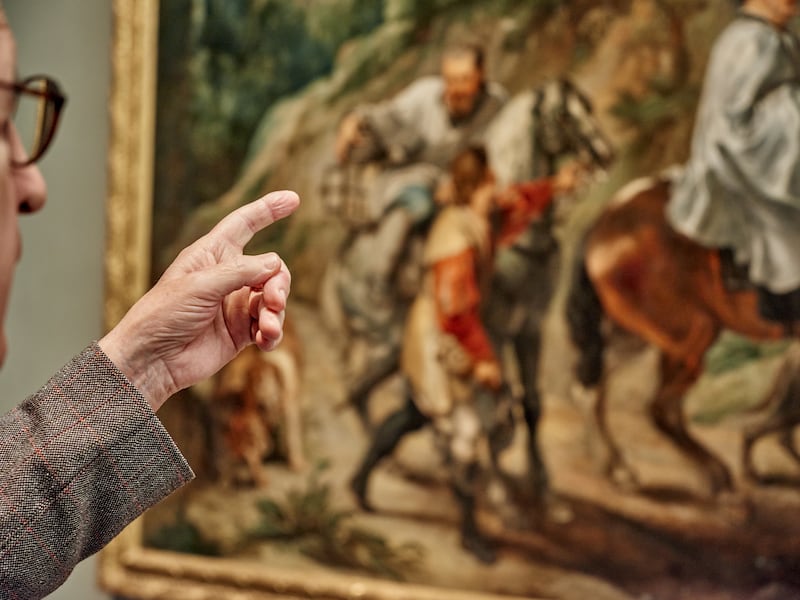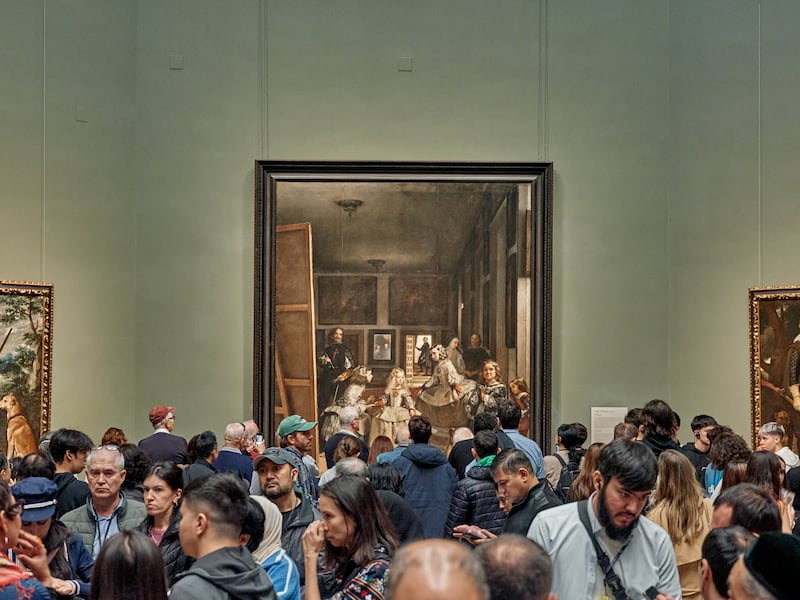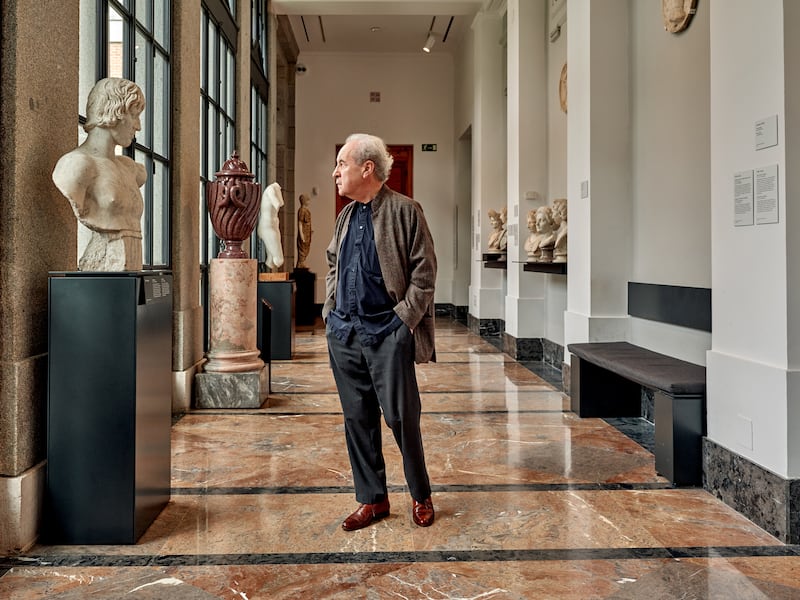On a rainy afternoon in Madrid, Irish author John Banville was in the Prado Museum searching for a Caravaggio.
The painting in question – Ecce Homo, or Behold, the Man in Latin – had a back story that was worthy of one of Banville’s novels. The work portrays Jesus before his crucifixion and for years had been attributed to a lesser-known Spanish painter’s even lesser-known student. When it surfaced at an auction house in 2021, the starting price was set around $1,800. Acting on a hunch that things were not what they seemed, Spanish authorities scuttled the sale and sent it to experts to determine its provenance.
Behold, it was a Caravaggio worth millions.
But as Banville walked, he kept getting distracted from his search: down one grand hall was a row of paintings of Spanish Habsburg royals, seated on horseback. Around another corner was a canvas by Diego Velázquez of the Greek god Bacchus doling out wine to a group of buddies, as one of them looked out at the viewer. “He looks like an Irishman at a feast,” Banville said. “‘More drink!’”
READ MORE
Banville’s presence at the Prado is part of an experiment: Since last year, the Prado has been bringing novelists to live in an apartment overlooking the museum. They stay for periods ranging from three to six weeks, but they are not expected to write there. All they have to do is look at the art – and, the curators hope, draw inspiration from what they see.
So far, South African novelist JM Coetzee and Polish fiction writer Olga Tokarczuk – both Nobel Prize winners – have come to the Prado, along with Anglo Mexican writer Chloe Aridjis, and Banville, who arrived this autumn. The project is called Writing the Prado, and is funded by the Loewe Foundation, the charitable arm of the Spanish fashion house.
Paintings and poems share a long history – ut pictura poesis, said the Romans, “as is painting, so is poetry.” WH Auden’s poem Musée des Beaux Arts is a tale about life’s unnoticed calamities; it describes a painting by Pieter Bruegel the Elder where the Greek Icarus is seen crashing from the sky as others go about their day. Anne Sexton wrote a poem about Van Gogh’s Starry Night.
“There’s nothing new about painting and poetry,” said Valerie Miles, editor of the Spanish edition of the literary magazine Granta who heads the selection committee for the residency. “But painting and narrative, that’s a different story.”
[ John Banville: ‘I expected to be dead, or at least gaga, by now’Opens in new window ]

And this is where the second part of the experiment begins: upon returning home, each writer is asked to create a work of fiction using the museum or its paintings as a point of departure.
The Spirit Level, a new Aridjis story that the Prado published in August, takes its name from the tool used to ensure a hung painting is aligned correctly on the wall – a process she watched during one of her first tours of the galleries last autumn. The story follows a fictional curator as she suffers from anguish and insomnia while mounting an exhibition at the Prado about Jerome, the Christian saint who translated the Bible in Bethlehem.
“As a writer I always identified with him in his study,” Aridjis said of Jerome, who is often painted at work, translating.
As Banville approached the rediscovered Caravaggio painting, he said he always loved a good back story. At home, the National Gallery of Ireland had found a Caravaggio of its own in 1990 at the house of a Jesuit, a work that for years was presumed lost. “It’s so good, people forget about all the other paintings,” he said.
At last, Banville entered Room 7 and gazed at Ecce Homo. A condemned and bloodied Jesus looked at his feet, forlorn, as a man in the shadows offered him a red cloth. There was an expression of desolation and immense physical pain. Banville touched his own shoulder, which he said aches after years of writing by hand.
Would the Caravaggio be his next subject? Maybe not. “I’d say the one in Ireland is a lot better,” he said.
In The Museum Guard, the story Coetzee produced after his stay, a middle-aged Madrileño named Pepe decides to take a security job at the Prado so he can settle into an easy existence, surrounded by the masterworks of Francisco Goya. “He has found his niche in life,” the narrator says. Soon, however, Pepe begins a series of unsettling encounters with a mysterious woman who starts to visit the museum.
During one visit, the stranger tells Pepe the story of how her husband drowned himself while the two were on vacation in Spain years before. In another meeting, the widow and the museum guard stand in a gallery before Goya’s The Drowning Dog, a portrait of an animal sinking in what seems to be quicksand, with only the hound’s head above the abyss.
Sometime later, Pepe discovers her identity when he sees the stranger’s photo on the back of a used book: She’s none other than Elizabeth Costello – Coetzee’s literary alter ego and a character in at least four other books – who now makes her latest appearance in The Museum Guard. (If this weren’t meta enough for the reader, Costello then goes on to compose her own fictional account about the Prado involving Pepe – thus allowing Coetzee’s alter ego to write about the museum as part of the real Coetzee’s assignment to do the same thing.)
Back in the galleries this autumn, Banville was inspecting an exhibition set to open the following week, Rubens’s Workshop, which will run until the end of February and combines a dozen or so paintings by the Flemish Old Master with a partial reconstruction of his studio in Antwerp, Belgium. The paintings were on the wall, but parts of the reconstruction weren’t finished yet and there was the loud noise of a power drill as the writer entered the room.
Alejandro Vergara, the curator in charge of the show, invited Banville to look at two portraits of Queen Anne of Austria, nearly identical save for the fact that the brushstrokes on one looked much rougher and more unfinished than those on the other.
“One of these was a workshop copy,” Vergara told Banville. “Which do you think is the original?”
It was a trick question, of course: The “original,” by Rubens’ hand, was the scrappier of the two, whereas the other painting was the copy. Banville leant in to take a closer look at the original as Vergara shined a high-powered flashlight on a piece of lace, where you could see evidence of Rubens working out how to do the brushwork. Then he looked back at the duplicate.

“It’s an awfully good copy, isn’t it?” the writer said.
Tokarczuk, the Polish Nobel laureate, has been working on her piece of fiction from her home outside of Wroclaw
since she left the Prado late this spring. The story hasn’t been published yet, but in answers to written questions, Tokarczuk described a tale that takes the form of a fictional interview whose scope seemingly goes well beyond the museum.
“I’m really struggling with two wars – Ukraine and Israel. I can’t understand how a man who wants to fly to Mars can simultaneously lead such devastating conflicts in which innocent people die,” she said, referring to Russia’s Vladimir Putin, who has announced plans for space missions while leading Ukraine’s war.
The piece also touched on climate change, she said.
Miguel Falomir, director of the Prado, said part of the motivation for asking novelists to write about the museum is that inevitably they will see things differently than a professional art historian does. “For me, I can’t look at a painting like ‘Las Meninas’ by Velázquez without seeing it through the academics that wrote about it before,” he said. – This article originally appeared in The New York Times.


2024 The New York Times Company













